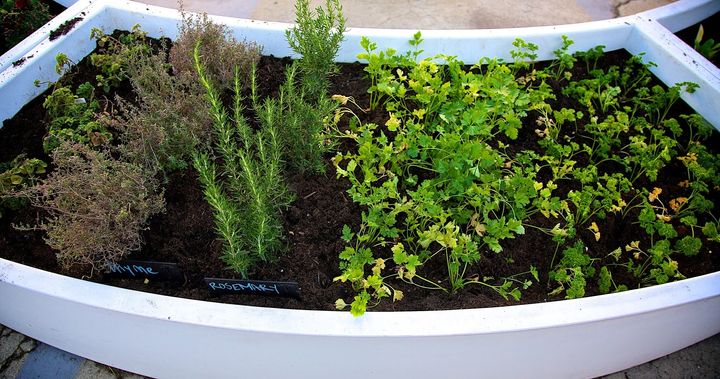If we want healthy food as the norm then we need to start with school-aged kids, providing hands-on experiences with positive results

The sun was strong, but the air was cool in Boulder CO. Tighe Hutchins, National Director of The Kitchen Community (http://tkc.org) and I were walking down Pearl street towards 8th street where she was going to show me an example of a “Learning Garden,” the simple, modular garden that is easy to install in schoolyards. Through a Learning Garden, school-aged kids witness the natural magic of healthy food from the sprout to the plate.
As we walked and talked she shared the facts and figures of The Kitchen Community in an understated yet confirming way. She’d accentuate each sentence with a brightness, a pointed enthusiasm that seemed to mute the noise around us. It takes a humble dedication to pursue a career in serving others, and when speaking with Tighe a thrill comes through the tone of her voice. It’s an intoxicating joy, a warmth.
Though the Kitchen Community is a Boulder-based non-profit org they’ve begun work in schools in a handful of cities such as Denver, Chicago, Indianapolis and LA. The Kitchen Community is dedicated to “strengthening communities by accelerating the real food movement at scale.”
Tighe begins to expand on this mission, “Real Food for Everyone. For us the start looks like building a thousand learning gardens by joining ten cities across the country by 2020. That is really the big picture about what we’re trying to do.”
“Learning garden?” I follow-up.

You need a garden
“A learning garden is a space on a school yard. We looked at school gardens across the country and asked, ‘What were the good things and what were the bad things that were happening in the realm of school gardens.’ So we designed the learning garden to solve the issues we saw, and be scalable.” Tighe paused, to make sure I was following. She continued, “The gardens stand at about 19 inches tall so that kids can easily access them and teachers don’t have to be bending over as much as they do to in a traditional school garden and we design them to be in the forefront of the school yards. So traditionally school gardens have been put in the corner of the school yard behind a fence and what we decided to do was bring it to the forefront and bring it to the priority of the school yard, and design something that was truly unique in design and last more than a few years. Our learning gardens are designed to last anywhere between 10-20 years, we designed them to fit every schoolyard.”
I envision the timeline, “What if a student had a learning garden throughout their primary education stating when they were in kindergarten up to when they graduated high-school. What would their life look like? What if not just one school or one student but what if hundreds of thousands of students had access to that throughout their primary education? How would we change food?” Tighe must be reading my mind, she continues…
You need to scale
“That’s really why the idea of scale came about. Because the problem is large, the problem is ginormous in America, people knowing where food comes from, people knowing how to grow food. Young people having access to that experience in urban environments.”
“What is the ideal state… a thousand schools? Or a dozen schools and the food system changes?”
“It’s not just about our organization, this is about a larger movement that starts where every student will have access to a garden space and know where their food is from…like a playground, it’s pretty normal to have a playground in the school, we want it to be normal to have a garden too.”
“So in the big picture you’re catalyst is the community for positive change?” I ask.

You need to think of the long-term impact
“Yes, and food is the way in. We work extremely hard to build our learning gardens and make sure that teachers are comfortable in the space and they’re feeling good about how to use this space on the back end. What we’ll see is more parents are engaged because students like talking about the learning garden with their parents, more often then they’re talking about anything else at school. So then when they go home and talk to their parents about what they had learned in the learning garden, a parent becomes curious about how why is my child learning about kale and collards and radishes. And go to the grocery market and asks questions, ‘What is kale? How do I cook it?’ That sends the outreach to their neighbor who’s growing cucumbers and there’s these connections that we see that grow from a real community based around the school yard…
It’s really up to the students
“The students actually become the guardians of the garden so they’re in charge of protecting it and they really take ownership of it. But what we learned in the last 5 years is that you can’t just build the garden yet. And then expect it to be utilized by teachers who may or may not have had interactions with outdoor classroom training, or gardening at all. So then our team on the ground runs programming for the teachers to actually train them on key garden skills and then once they establish their garden skills, then they get a curriculum to incorporate into the school day in the various areas that we run throughout different levels of education to be able to make sure the garden is being utilized during the school day and not after school activities.”
“And you’ve seen success so far?”

And when it works, it “goes viral”
“Yes, the movement has grown quickly over the past 5 years. We built one garden in 2011 and we were in one city. Now we’re in 6 cities and built 300 gardens and we actually have cities asking us to come to them and come and do this. Which, if you asked me 5 years ago about half the people we were working with, I would be more challenged to even say… ‘This is a garden, what do you think about that?’ So we are having people engaged in conversation, we are having so much fun with the idea that people are trying to engage us in the conversation. They are really trying to bring us to them.”
To learn about more trailblazers and innovators like Tighe go here: http://www.verizon.com/about/news-tag/designing-innovation
Go here to learn more about the Kitchen Community: http://tkc.org
